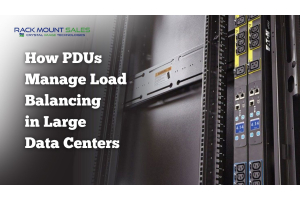Tips for Proper Installation and Maintenance of Rackmount Monitors
Rackmount monitors play a crucial role in various industries, including data centers, server rooms, and control rooms. These monitors are specifically designed to be installed on standard equipment racks. These monitors are mostly used where space is limited and where compact design is required. It helps save valuable space and provides efficient visual display solutions. However, for optimal performance and longevity, proper installation and maintenance of rackmount monitors are essential. That’s exactly what we are going to discuss here. Here are some useful tips for installation and maintenance of rackmount monitors, if you are planning to use them.
- Plan and Prepare
Before diving into the installation process, you should plan and prepare accordingly. Start by assessing the rack space available and determining the ideal location for the rackmount monitor. You need to ensure that the rack is sturdy and can support the weight of the monitor without any issues. Consider the proximity to power outlets, video sources, and any necessary cabling requirements before installation.
- Follow Manufacturer Guidelines
Each rackmount monitor comes with specific installation guidelines provided by the manufacturer. You need to read and properly follow those instructions meticulously. The manufacturer's guidelines will outline the necessary steps. It includes mounting hardware, cable connections, and any specific considerations for your particular model. Deviating from these guidelines can lead to installation errors and potential damage to the monitor. So, you need to thoroughly read and follow those manufacturer guidelines in order to prevent any errors.
- Rackmount Compatibility
Verify the compatibility of the rackmount monitors with your equipment rack. Different racks may have different specifications, such as hole patterns and depths. You need to ensure that the monitor's mounting brackets align with the rack's holes or utilize adapters if needed. Avoid making any modifications to the rack or the monitor that may compromise their structural integrity.
- Cable Management
Proper cable management is vital for maintaining a clean and organized installation. That’s why, you have to make sure that all cables are neatly routed and secured to prevent tangling or accidental disconnection. Labeling the cables can aid in troubleshooting and maintenance tasks in the future. Consider using cable management accessories such as cable ties, clips, or cable management arms to streamline the process.
- Cooling and Ventilation
Heat dissipation is a critical factor in the proper functioning and longevity of rackmount monitors. This is the same as any refrigerator or any electronic. Just like that, you need to ensure that the rack has adequate ventilation and airflow to prevent overheating. Avoid blocking air vents or placing other equipment that may obstruct the monitor's cooling system. Make sure to regularly clean the ventilation ports and fans to remove any dust or debris that could impede airflow. This will help in the longevity of rackmount monitors.
- Regular Cleaning
As mentioned earlier, regular cleaning is essential to maintain the performance and visual clarity of rackmount monitors. Dust can accumulate over time, and can affect the monitor's display quality and potentially causing overheating. Make sure to regularly clean your rackmount monitors by the use of a soft, lint-free cloth for the monitor’s screen, and external surfaces. Do not use harsh chemicals or harsh materials as they could damage your monitor's coating.
- Power Surge Protection
Invest in a reliable power surge protector or uninterruptible power supply (UPS) to safeguard the rackmount monitor against power fluctuations and electrical surges. Sudden power spikes or outages can damage the monitor's internal components and lead to costly repairs or replacements. Ensure that the surge protector or UPS is properly grounded and rated for the monitor's power requirements.
- Regular Inspections
For maintaining your rackmount monitors, you need to perform routine inspections of the rackmount monitor so that you can identify any signs of wear, loose connections, or malfunctioning components. Check the cables, connectors, and mounting brackets for any damage or signs of stress. Promptly address any issues to prevent further damage and ensure uninterrupted operation.
- Firmware Updates
Stay up to date with the latest firmware updates provided by the manufacturer. These updates often contain bug fixes, performance enhancements, and new features. Regularly check the manufacturer's website or subscribe to notifications to ensure you have the most recent firmware installed on your rackmount monitor.
- Professional Assistance
If you are uncertain about the installation or maintenance procedures, you should seek professional assistance. Professional technicians have the knowledge and expertise to handle complex installations, troubleshoot issues, and they can provide proper maintenance for rackmount monitors. They can ensure that the installation is done correctly and in accordance with industry standards, minimizing the risk of damage or operational problems.
- Avoid Overloading
When installing rackmount monitors, it is important to consider the weight and load capacity of the rack itself. Each rack has a maximum weight capacity that should not be exceeded. Be mindful of the combined weight of the monitor, cables, and any additional equipment or accessories mounted on the rack. Overloading the rack can lead to structural damage or instability, posing a risk to the monitor and other equipment.
- Consider Environmental Factors
The environment in which the rackmount monitor is installed plays a significant role in its performance and longevity. Factors such as temperature, humidity, and exposure to dust or moisture can impact the monitor's operation. Ensure that the installation location provides suitable environmental conditions within the manufacturer's recommended ranges. In harsh or extreme environments, consider using protective covers or enclosures to shield the monitor from potential damage.
- Secure Mounting
Properly securing the rackmount monitor to the equipment rack is crucial to prevent accidents or damage. Ensure that the mounting brackets are securely fastened to the rack and that the monitor is stable and level. Perform a thorough check to verify that all screws or bolts are tightened appropriately. Regularly inspect the mounting hardware to ensure that it remains secure over time.
- Maintain a Service Log
Keeping a detailed service log for your rackmount monitor is a good practice for tracking maintenance activities, repairs, and any issues encountered. Documenting the date and details of each inspection, cleaning, firmware update, or professional service can help identify patterns or recurring problems. It also serves as a valuable reference for warranty claims or when seeking technical support.
- Monitor Calibration
To achieve optimal visual performance, consider calibrating the rackmount monitor periodically. Calibration adjusts various parameters such as color accuracy, contrast, and brightness to ensure accurate and consistent image reproduction. Consult the manufacturer's guidelines or seek assistance from a professional calibrator to ensure precise calibration settings.
- Implement Safety Measures
Safety should always be a top priority when working with rackmount monitors or any other equipment. Follow proper electrical safety practices, such as disconnecting power before performing any maintenance tasks. Use appropriate personal protective equipment (PPE), such as gloves and safety glasses, when handling the monitor or working in the vicinity of live equipment. Adhere to industry safety standards and guidelines to minimize the risk of accidents or injuries.
- Keep Documentation and Manuals Handy
Retain all documentation and manuals that come with the rackmount monitor in a safe and easily accessible place. These resources provide valuable information on troubleshooting, maintenance procedures, and warranty terms. In case of any issues or queries, having the necessary documentation readily available can expedite the resolution process.
Conclusion
Proper installation and maintenance of rackmount monitors are vital to ensure their optimal performance, longevity, and reliability. By following the tips we have discussed in this article, you can minimize the risk of installation errors, equipment damage, and operational issues. Additionally, you can maintain your rackmount monitor efficiently. Plan and prepare adequately, adhere to manufacturer guidelines, practice cable management, and prioritize cooling and ventilation. Regular cleaning, power surge protection, and routine inspections are essential for the monitor's upkeep. Stay updated with firmware releases, consider professional assistance when needed, and prioritize safety at all times. By implementing these practices, you can maximize the value and functionality of your rackmount monitor investment.











